Yeah that nasty 4 letter word got me.....No...Not Sick,
Work, I will post something as soon as I can. Read the guys on the sidebar, they write
better than I du,
The musings of a politically incorrect dinosaur from a forgotten age where civility was the rule rather than the exception.
Yeah that nasty 4 letter word got me.....No...Not Sick,
Work, I will post something as soon as I can. Read the guys on the sidebar, they write
better than I du,
Everyone knew about the German "Volksturm" with this picture being Iconic for the group.
Well the Japanese had the same kinda thing, and most people didn't know about it. I remember seeing pictures in my WWII books of Japanese soldiers teaching Japanese civilians how to use bamboo spears to attack the American soldiers after they set foot on the homeland. I also know after a few incidents of this plus of the bloodbath of Okinawa, we would have had to eradicate the Japanese as a people and a culture to beat them. and anything less than an unconditional surrender would mean fighting the japanese in 20 years after they rearmed and got smarter and we had demobilized as we tend to do after a major conflict. Hitler Germany taught that little lesson. So when I hear about the revisionist talk about that we should have not used the A-bomb on the Japanese I know that they don't really know history and that they are apologist for the Soviet Union Er the Marxist movement.
I shamelessly clipped this from "American Rifleman"

“The bulwark of this Volkssturm in Japan proper is the Second National Army, which in peacetime consists of a large group of untrained males of military age. With the small amount of training now being given this group and with the formal registering on its rolls of all 17- and-18-year-olds since November 1944, the use of civilians in the defense of the Japanese homeland begins to assume increasing military importance.”
—Secret U.S. Military Intelligence document from the Pacific Theater of Operations, March 1945
While the Allied concept of “unconditional surrender” of Axis forces in Europe was sound, the prospects of a national Japanese surrender seemed unlikely. Before anyone knew anything about the war-ending potential of the atomic bomb, American military planners had to prepare to overcome a fanatical defense of the Japanese home islands—a battle during which the Japanese military appeared ready to sacrifice their entire population to protect their homeland.
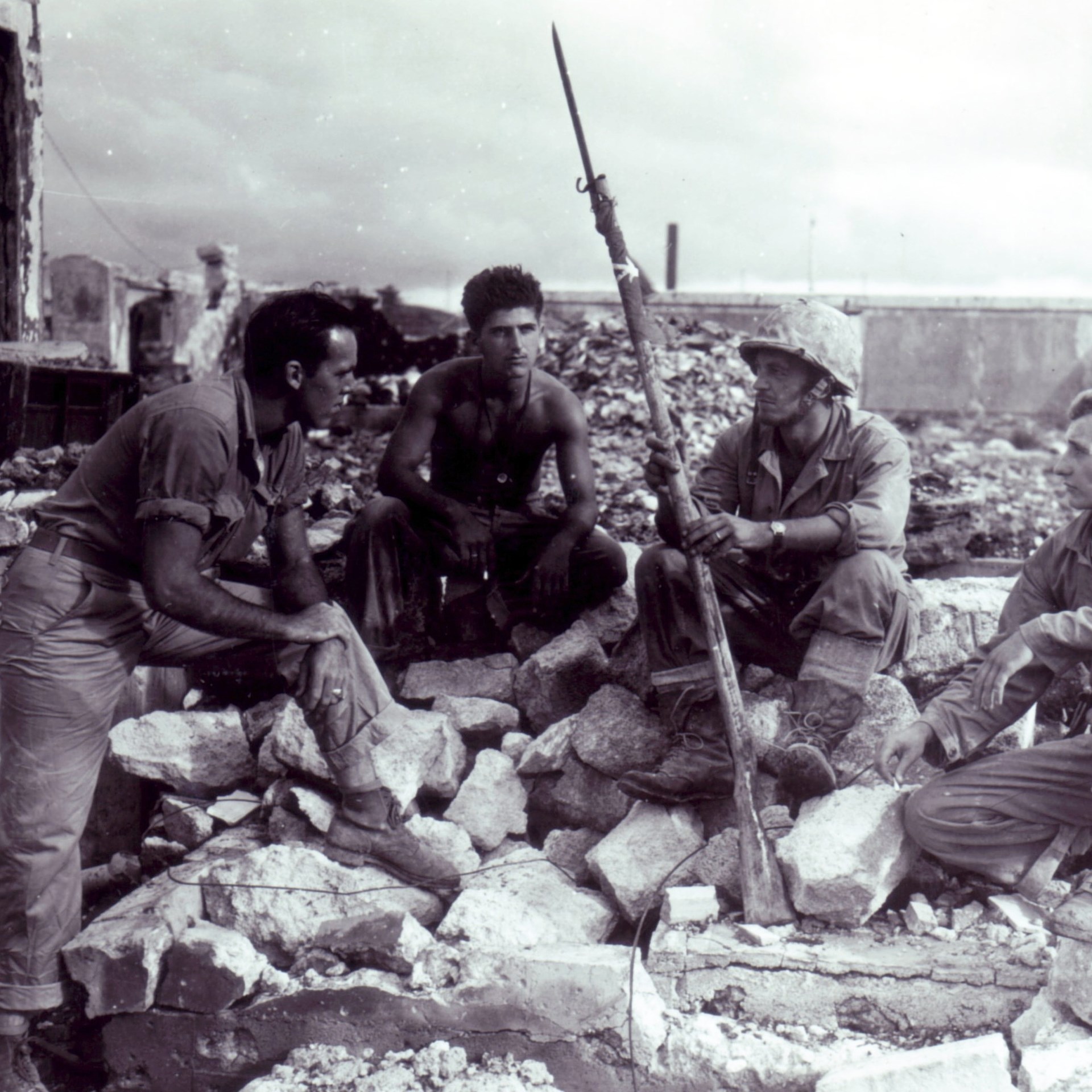
But while the Japanese spirit was willing, their physical resources were growing weak. The emperor’s forces struggled to provide enough firearms and ammunition to their combat troops. To train and supply a large civilian militia with effective modern small arms would require extreme ingenuity to match the traditional Japanese willingness to sacrifice. Consequently, the Japanese would develop some of the crudest firearms of World War II.
Setting The Stage For Operation Downfall
Allied leaders concluded that they could not wait for a blockade and intensive bombings to bring about a Japanese surrender—a massive invasion of the home islands was necessary. Meanwhile, a timeline was set for the defeat of Japan within one year of the surrender of Germany. The larger plan, dubbed “Operation Downfall,” was divided into two parts: Operation Olympic and Operation Coronet.
Olympic was to be the invasion of Kyūshū, scheduled for Nov. 1, 1945. Coronet was the second phase, with a massive force planned to invade Honshu in March 1946. All the main preparations were made without any knowledge of atomic bombs, and until the successful A-bomb test (July 16, 1945), it would have been folly to plan for the intervention of any secret weapon. A massive amount of brute force was the Allied recipe for success.
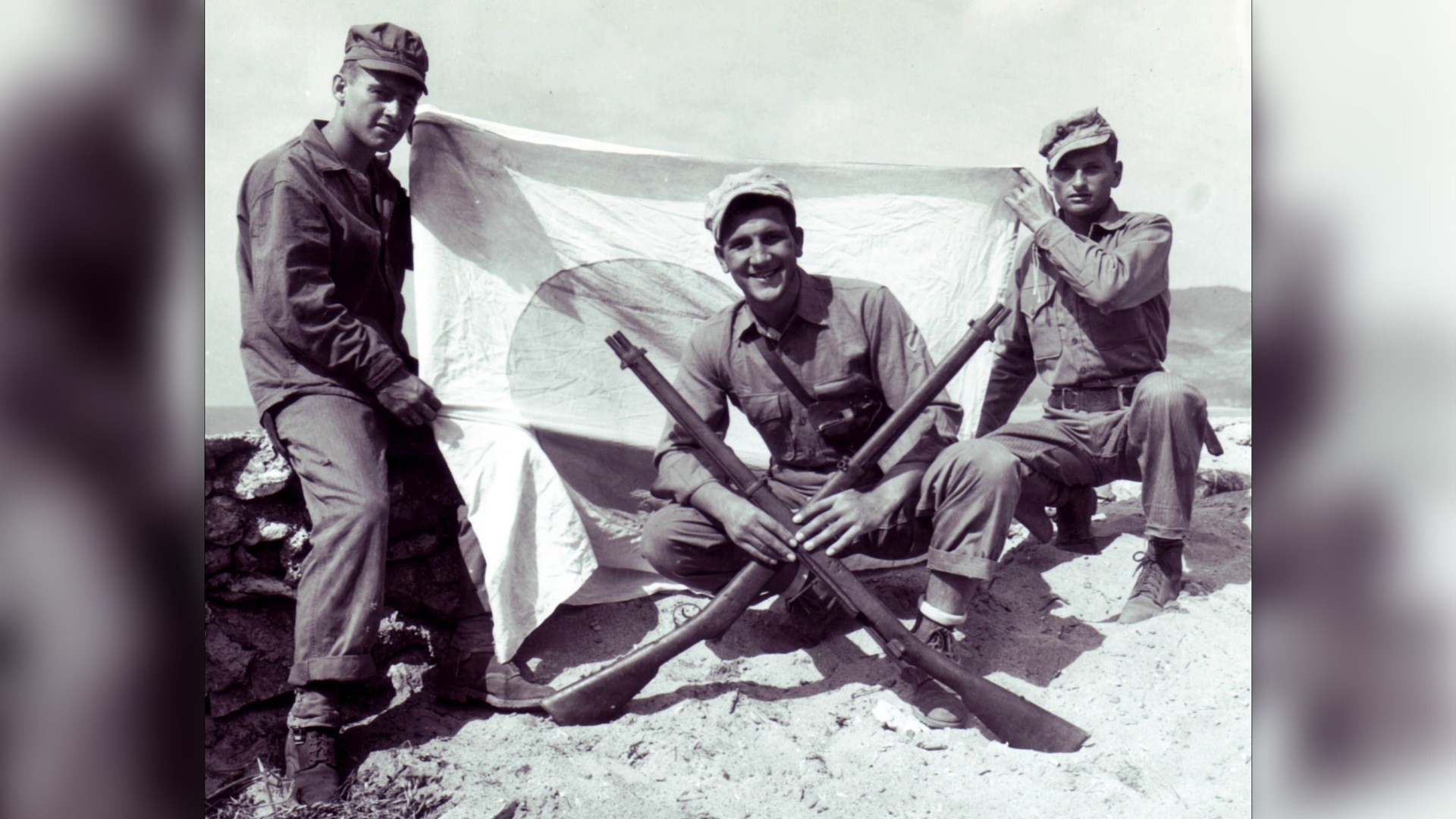
As American forces progressed in the island-hopping campaign, reaching islands closer to Japan proper, they encountered more Japanese civilians in the combat zone. These encounters provided a clearer picture of what Allied forces could expect when they invaded the Japanese home islands. American intelligence began to understand the scope of the Japanese militia, and the militarists plans for "The Glorious Death of One Hundred Million."
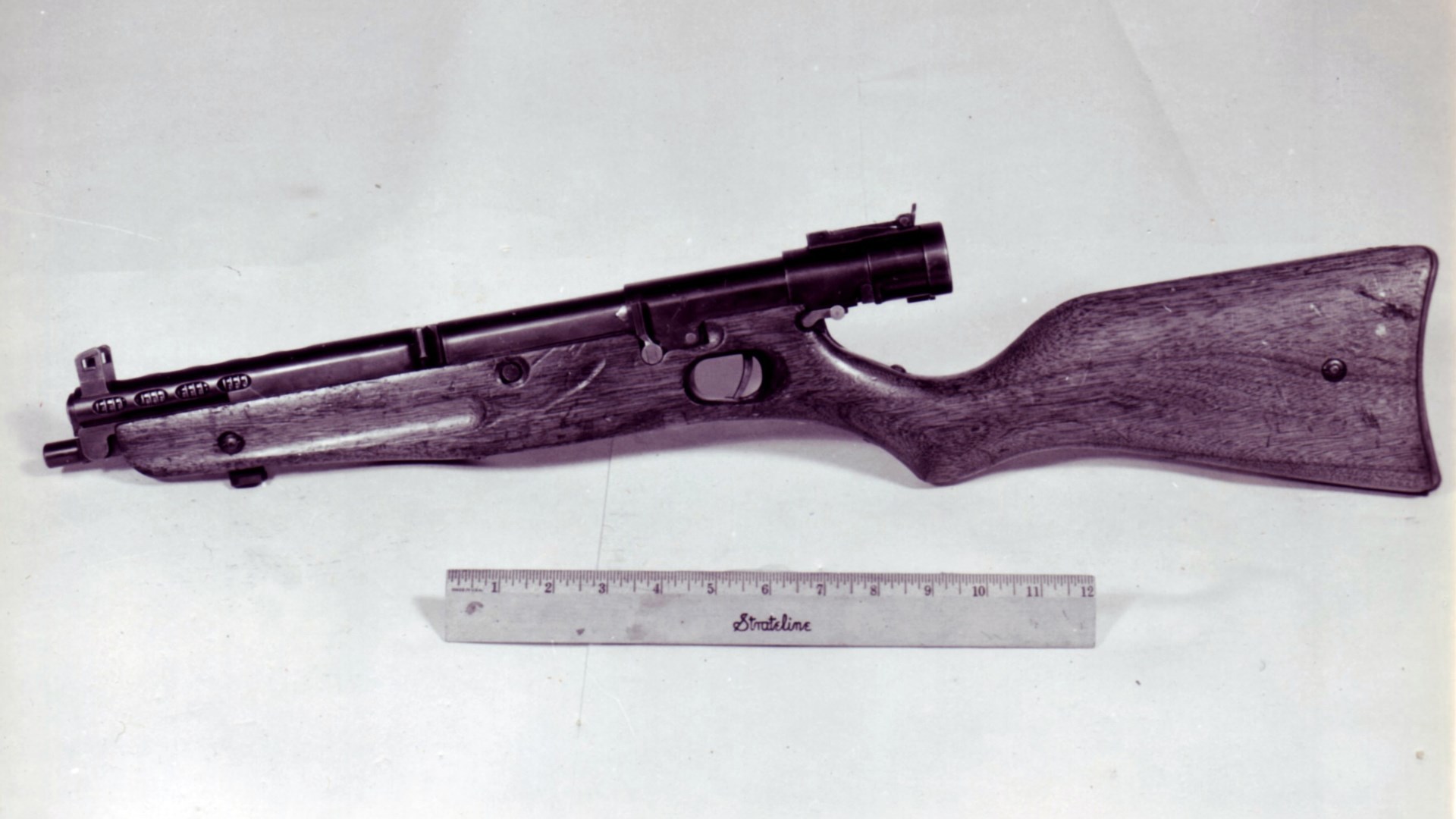
In a March 28, 1945, Military Research bulletin, American intel resources reported on the “employment of Japanese civilians in local defense:”
“It has long been the policy of the Japanese Army, even in peacetime, to keep close check upon all Japanese males of military age, not only as to whereabouts and amount of military training received but also as to education and occupational skills. This policy has been facilitated by assigning every fit male to a reserve component of the Army at the time of his conscription examination. In peacetime, those picked for conscript training, released after two years of active service, became members of the First Reserve. Those picked for a short term of replacement training formed the Conscript Reserve.
Both trained groups automatically entered the First National Army on reaching the age of 37. All other males 17-40 (now 17-44) who were not declared "unfit" became members of the Second National Army, a large body of untrained militia subject to call in emergency.
Japan has declared her intention to employ this reservoir of civilian manpower in local defense of the homeland and overseas areas, While It is true that Japanese civilians have not been used too effectively in the areas already attacked (see Bulletin 10), the following factors indicate that the employment of this Japanese "people’s army" will become more important as the war nears Japan Proper:
The available numbers, the past employment, and preparations made by the Japanese for the use of these civilian fighters, and the general methods of employment are discussed below.
It must be remembered that the Japanese Army will also continue to use natives as far as possible for military labor and as auxiliary forces, but this study is concerned only with the less variable use of Japanese nationals residing in operational areas.”
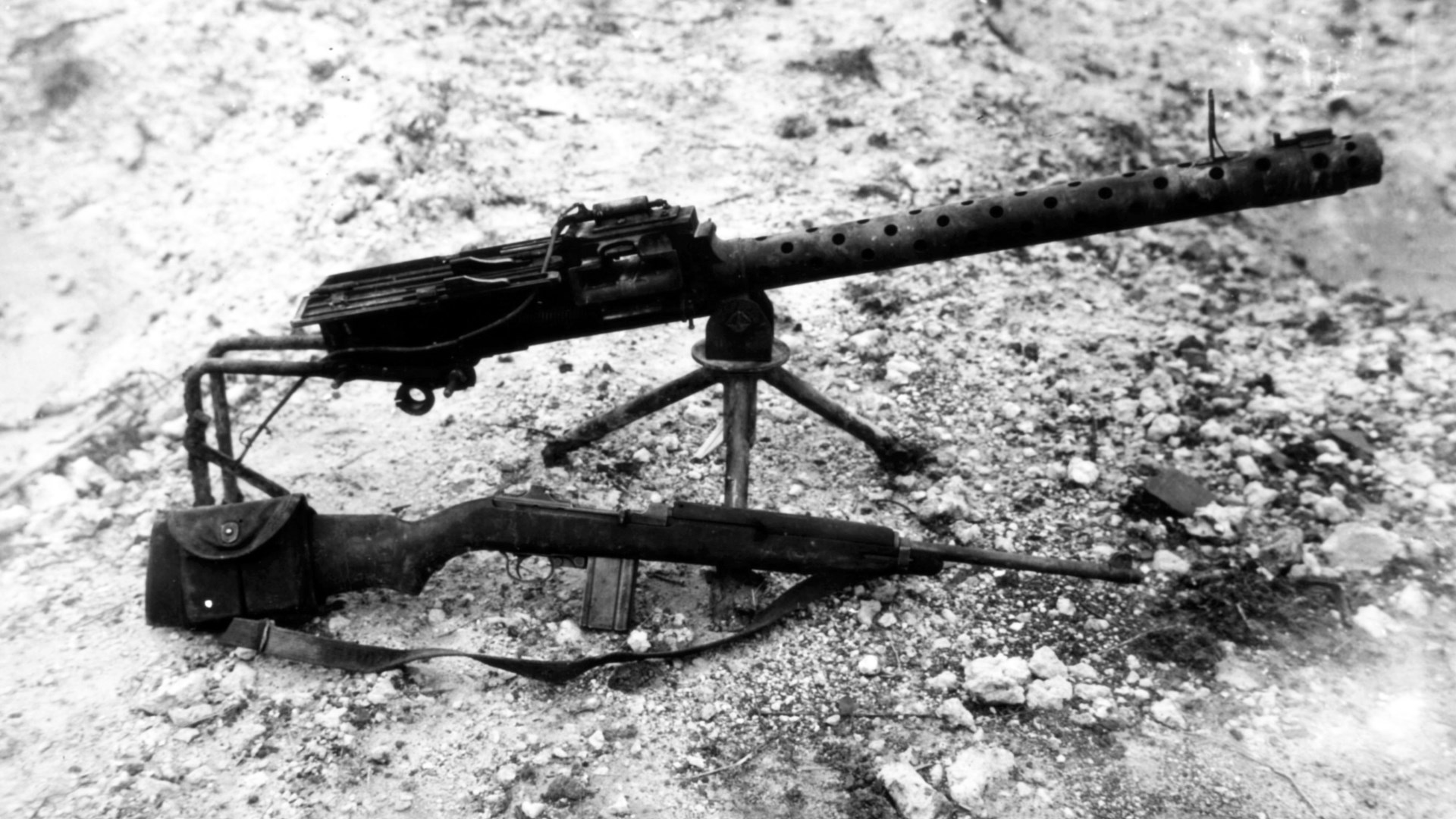
The report concluded that 17,450,000 men aged 15-59 were available as militia troops in the Japanese home islands.
“The proportion of the above numbers actually available as effective fighting men will be limited by several factors, including local administrative problems and the ability of the Japanese to arm and equip the personnel present in areas under attack.”
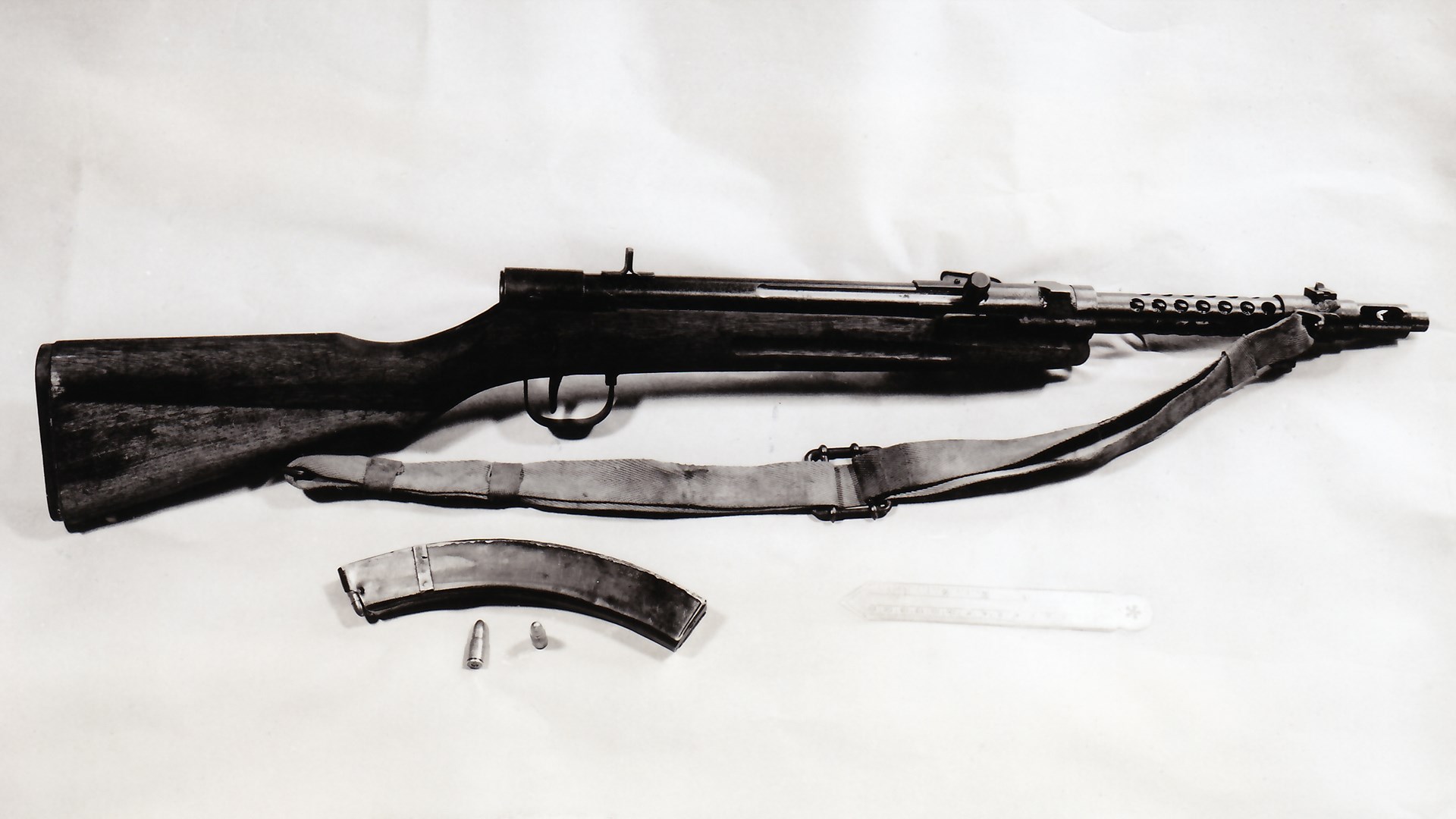
Relaxed Japanese Manufacturing Standards
U.S. troops in the field captured various new and modified Japanese wfirearms. Of particular interest were the modifications to the Japanese Model 99 (1939) Pattern 7.7 mm Rifle. These were detailed in an Ordnance intelligence report, produced in late 1944:
“A Japanese 7.7mm rifle of the Model 99 (1939) pattern, recovered in the Ormoc area, is of extreme interest as it Indicates a possible relaxation in the standard of manufacture. The points of variance between this and other rifles of the same model previously recovered are as follows:
According to a recently captured document, Japanese ordnance chiefs have expressed grave concern at the lack of essential ordnance supplies. With a view to remedying this condition, it was decided that the manufacture of certain items was to cease, while others were to be modified so that an intensified effort could be made to speed up production.”
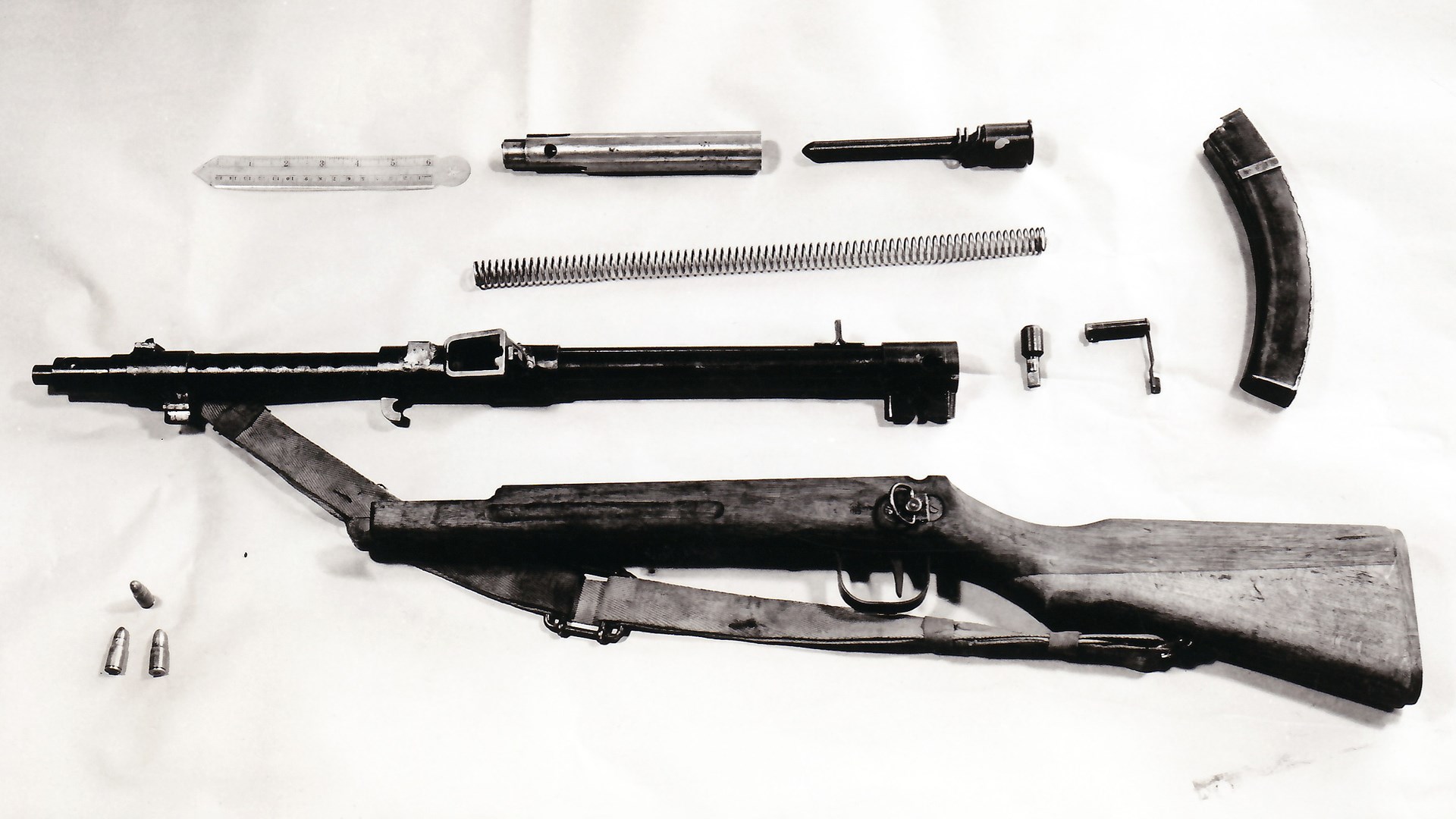
The Type 99 7.7 mm Substitute Rifle
In 1943, the Japanese decided to simplify the standard Type 99 rifle and make a “substitute standard” small arm. These modifications included eliminating the sling, cleaning bar and bolt cover, while substituting inferior steel for parts like the bolt and barrel. The simplification eliminated the chromium plate in the barrel, used an inferior grade of wood for the stock, and revised the sight to a range of only 300 meters. This was called a Substitute Type 99 Rifle.
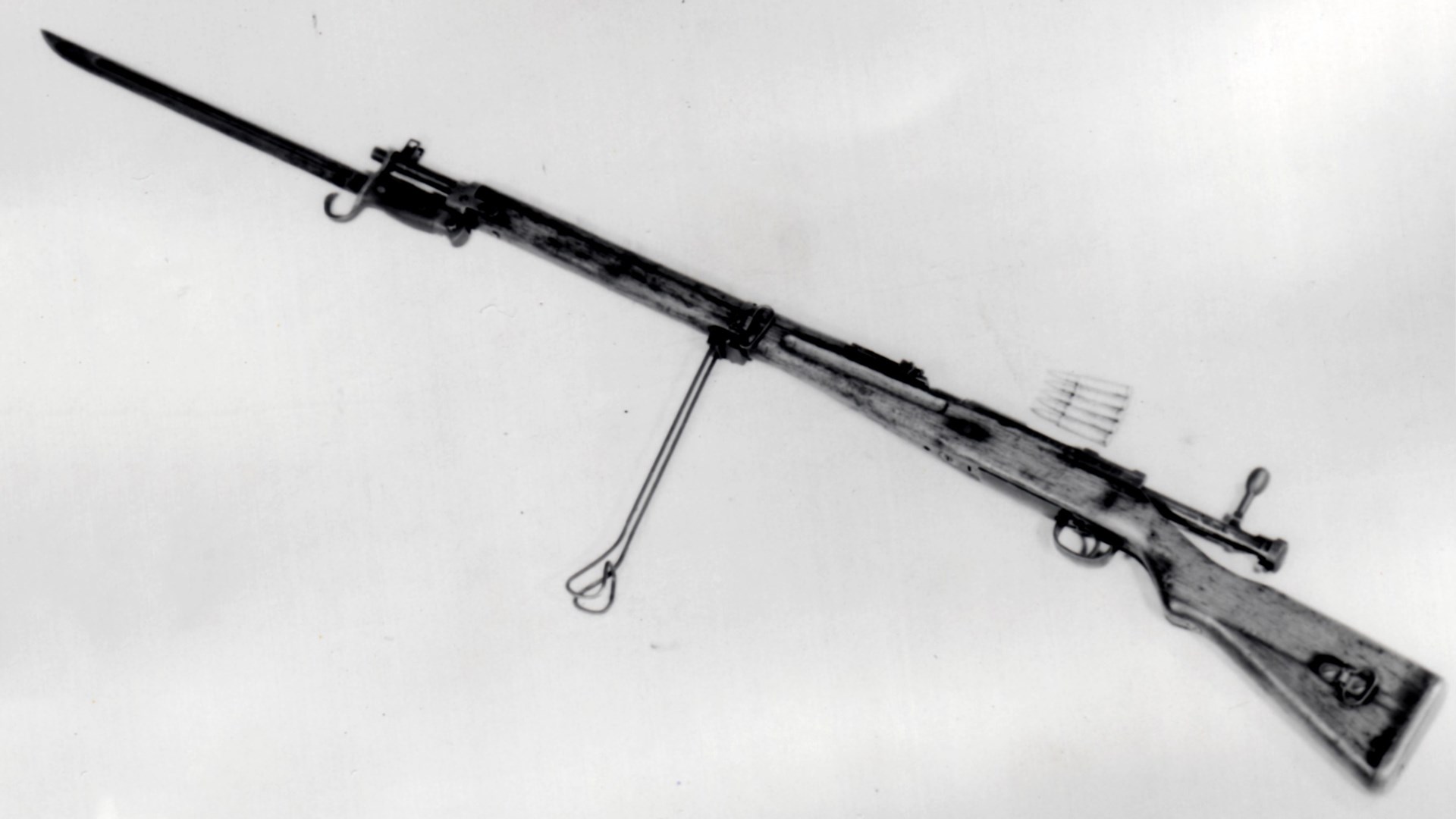
Japanese rifle collectors have uncovered a tremendous amount of information about the nuances of late-war Japanese arms production. Type 99 rifle collectors have described wide variations in the “Substitute Rifle,” including no serial or series number, unnumbered parts, mismatched parts, front sights missing guards, rear sights missing wings, alternate shapes to the bolt handle and varying types of butt plates.
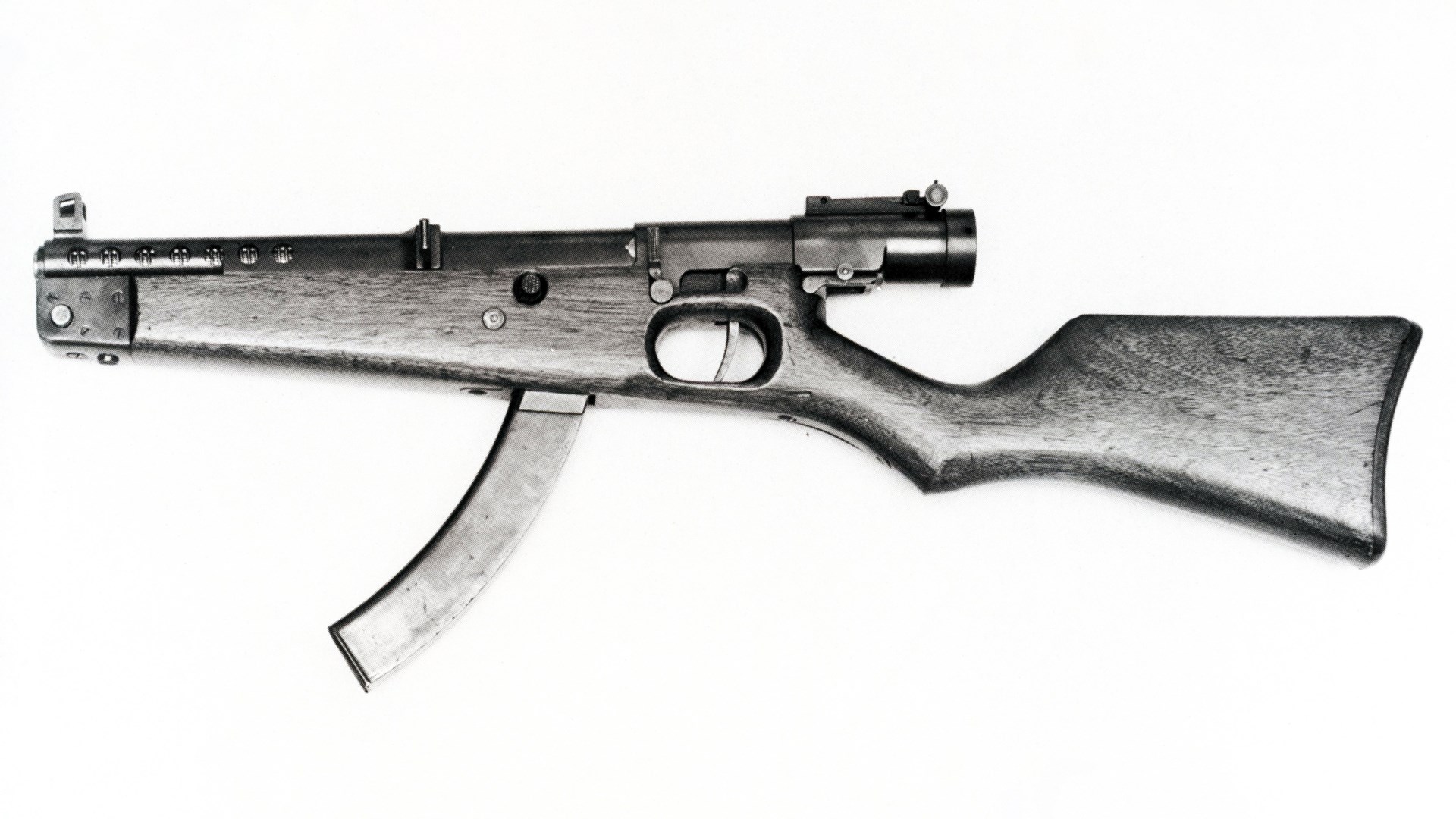
During April 1945, Japan made a significant change in its civil defense forces, designating them as civilian militia, and by June, conscription laws had been enacted even while the militia was renamed the Volunteer Fighting Corps (Kokumin Giyū Sentōtai). By the end of June, more than 25 million Japanese men were deemed “combat capable” by their hopeful government, but very few of them could be equipped with firearms of any kind. The Volunteer Fighting Corps did not see action during the war, but an early precursor, the local home guard on Okinawa, was equipped with obsolete rifles, most notably the Type 22 Murata rifles (11 mm). In the home islands, all that was available in the short term were spears, swords, axes, clubs and crossbows. Hand grenades were the most plentiful of modern weapons.
The Japanese "Simple Rifle:" Crude Weapons For The Massed Militia
Preparing for the invasion they knew would come, the Japanese embarked on a quick program of simple weapons development to equip their mostly untrained militia. The resulting firearms are some of the rarest guns of the entire war. The following descriptions (and photos) come from a series of U.S. Ordnance Technical Intelligence reports compiled during the first few months of 1946.
Simple 7.7 mm & 8 mm Rifles
A very simple rifle that would fire the standard 7.7 mm ammunition was attempted. The length of the barrel was 50 cm, and it was so simple in construction that it, as well as the other parts, could be made on an ordinary lathe. It was a bolt-action, single-shot piece that was intended to equip front-line defense troops in an invasion. However, as the ammunition proved too powerful, it was decided to make the rifle shorter and to use standard 8 mm 14th Year Type pistol ammunition, which proved much more satisfactory.
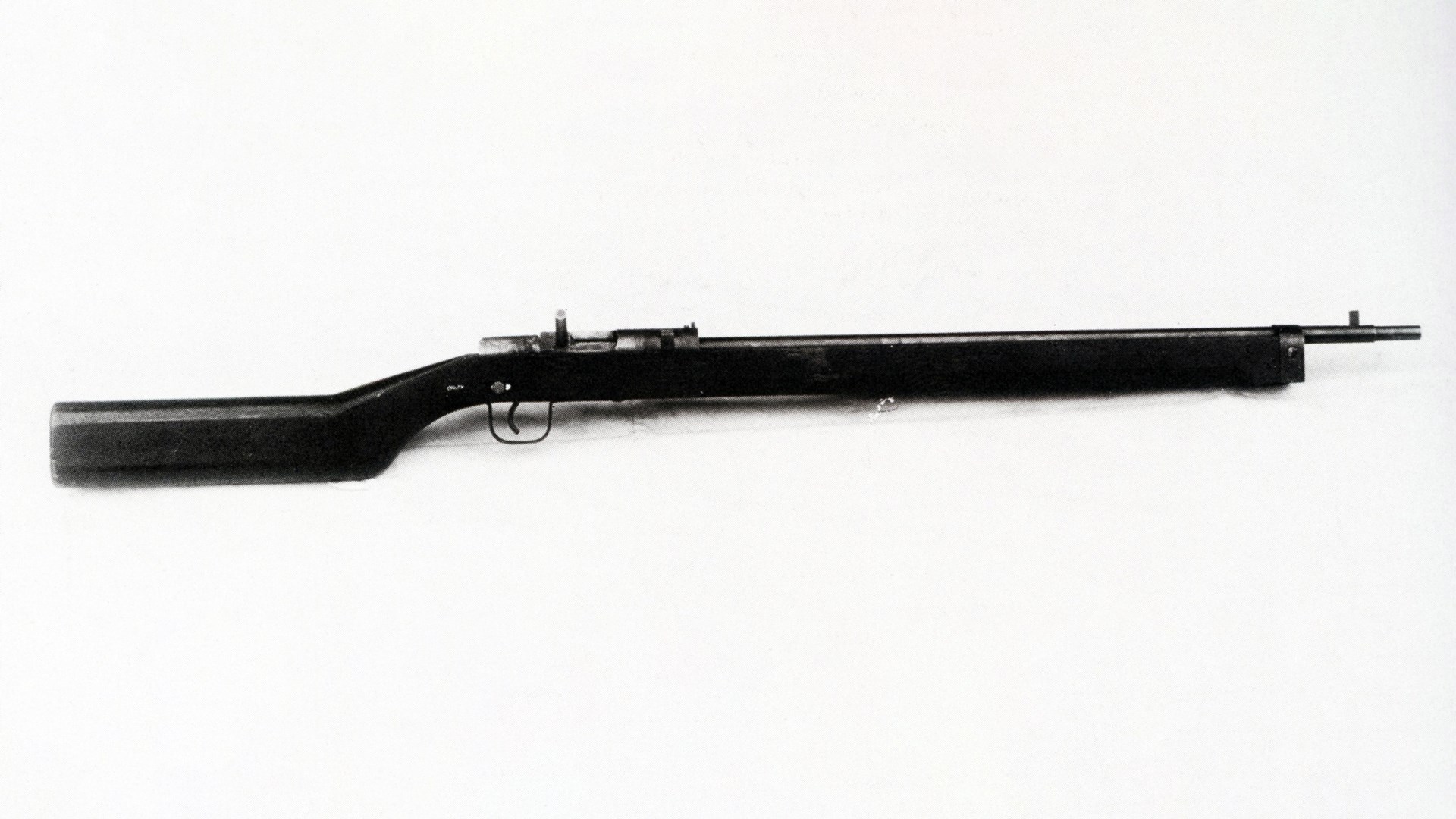
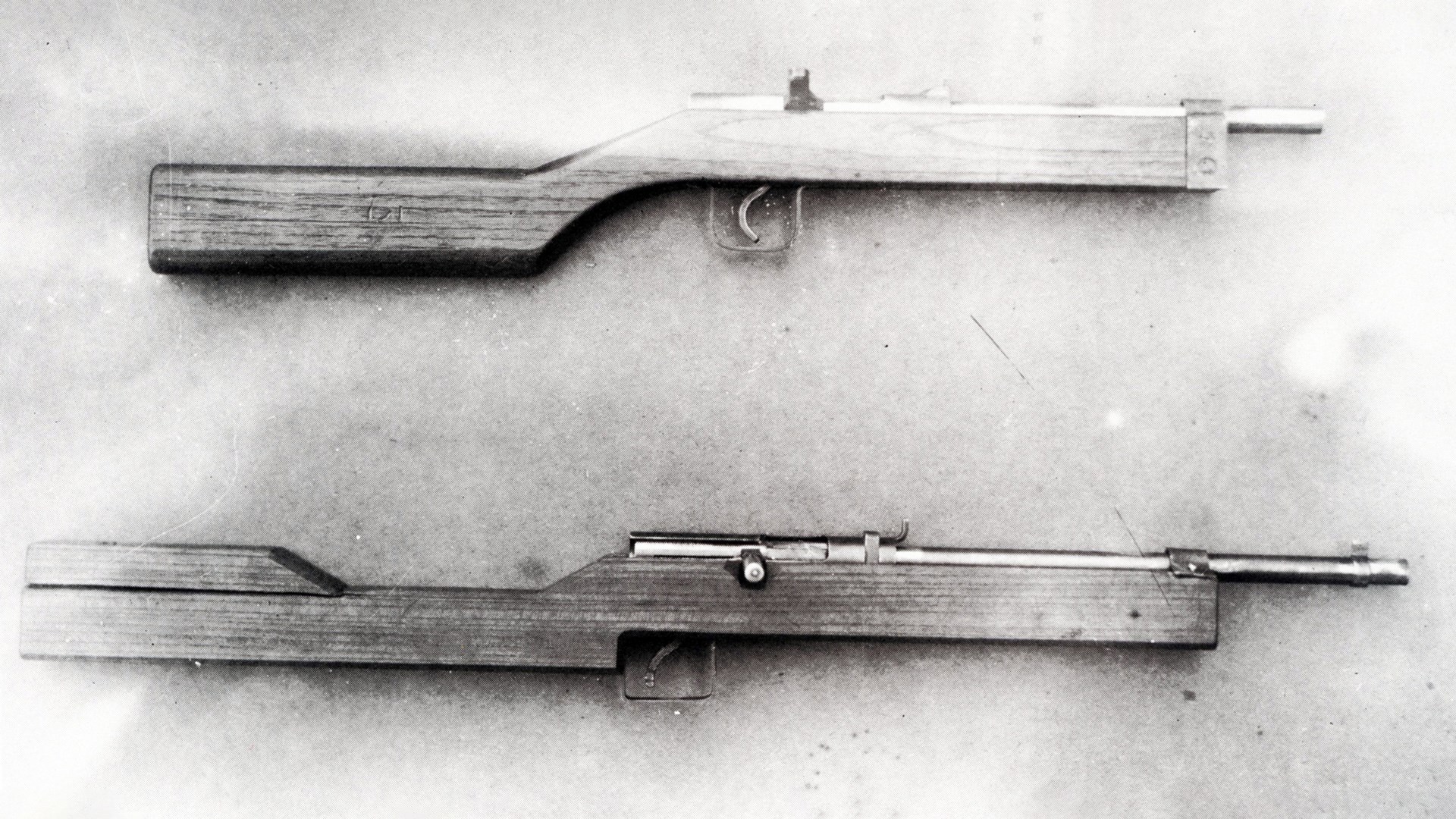
National Rifle & Pistol For Civilian Defense
This rifle was developed for the purpose of equipping volunteer defense troops and was a type that could be made by any small factory or smithy shop. The construction was simple as an ordinary piece of pipe (13 mm diameter) formed the barrel. It was loaded with 3 to 5 grams of blackpowder, and the projectile was made from ordinary bar stock cut in sections about 15 mm in length. It was fired by the hammer striking a primer-igniter cap that was placed over a small flash hole on top of the barrel. A pistol version of this firearm was also produced.
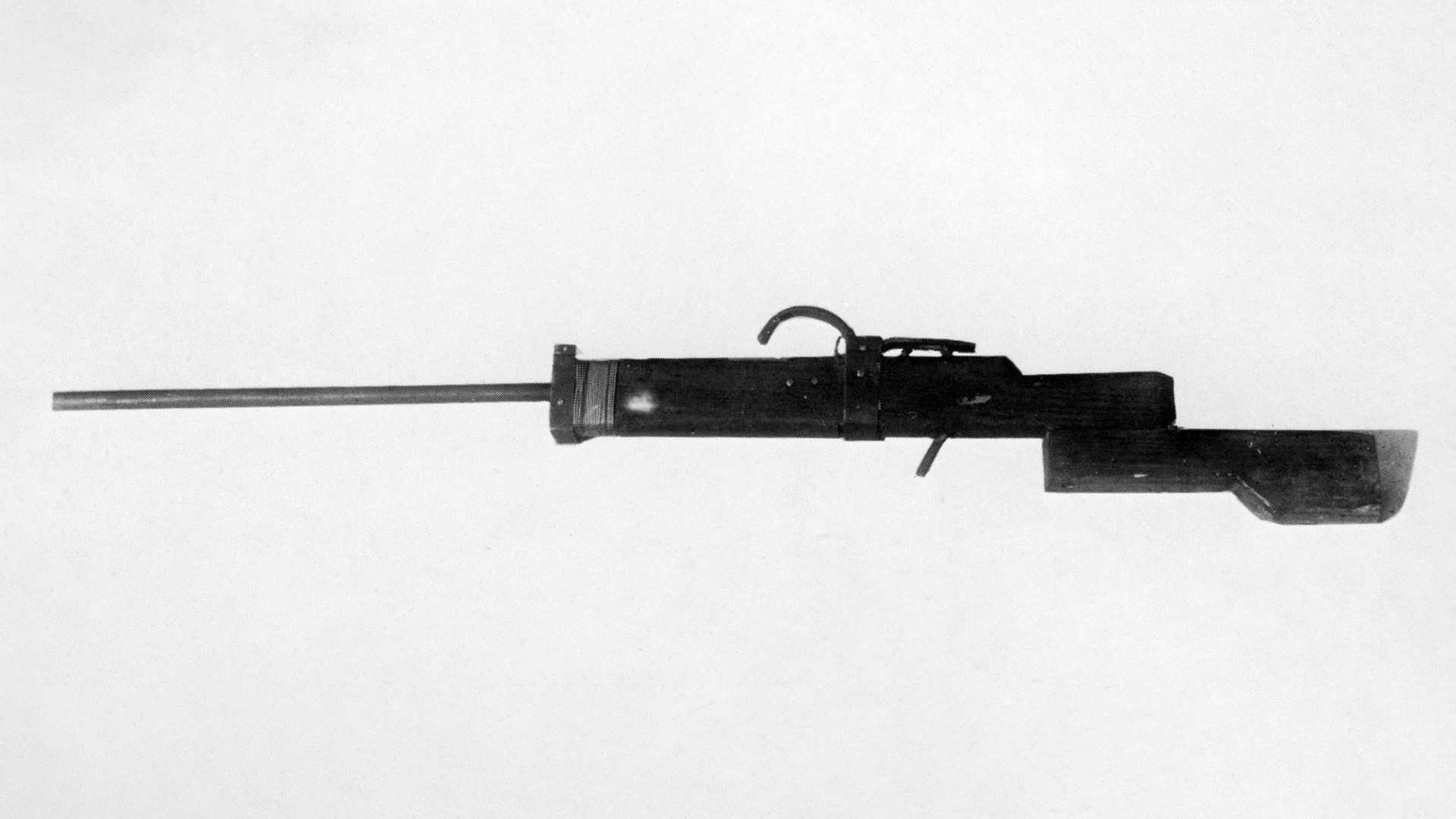
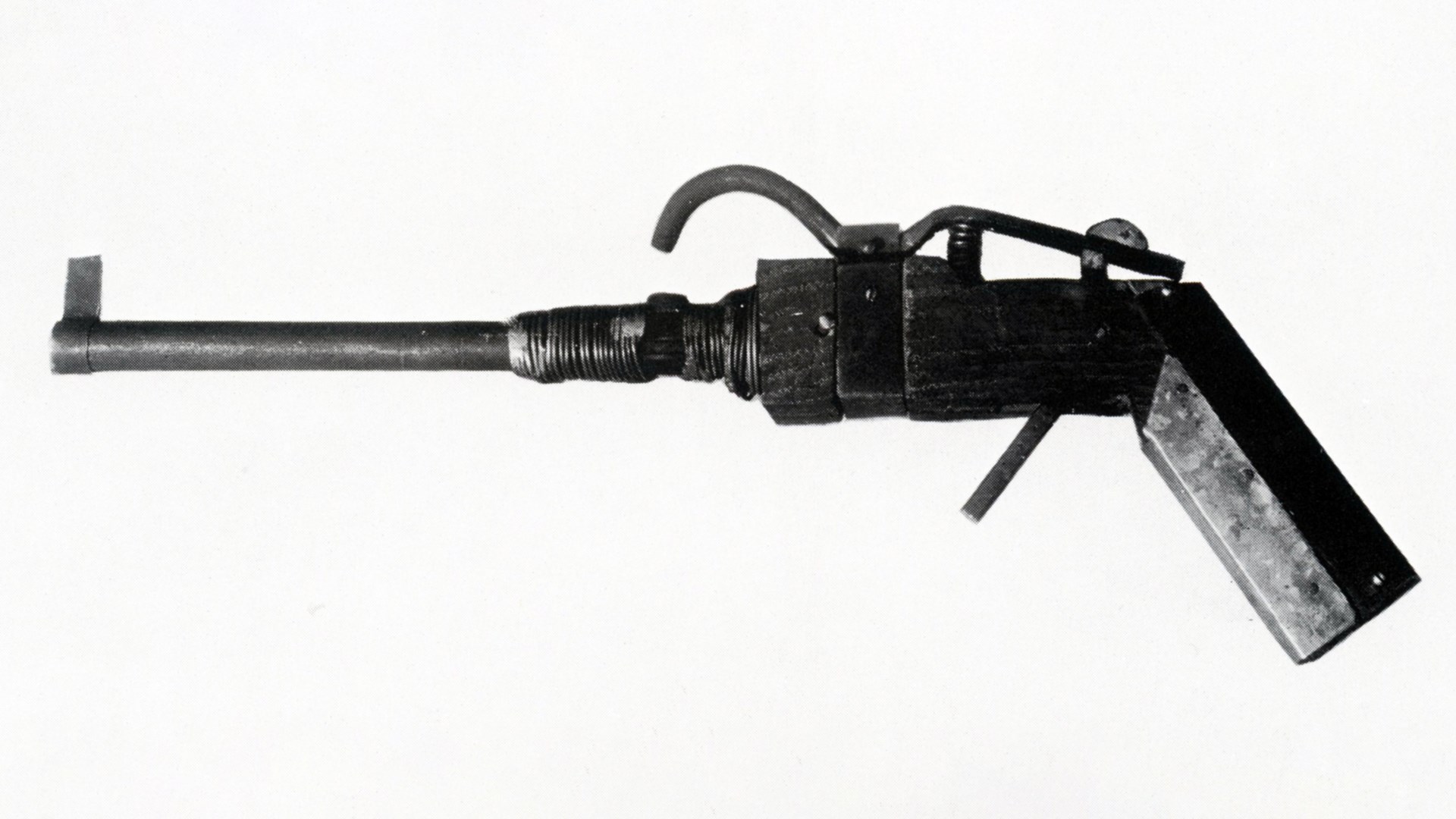
Type 5 Semi-Automatic Rifle (Garand copy)
The need for a semi-automatic rifle for the Japanese army was recognized in 1922, but the development of such a firearm was not begun until 1931 when several models were made; all proved unsatisfactory. This study lasted until 1937, at which time research was temporarily discontinued.
In March 1941, the inquiry was again started because of the progress on semi-automatic rifles in foreign countries. At this time, the 1st Section and the Kokura Army Arsenal designed several types of recoil and gas-operated rifles. The results of tests showed that none of the models were entirely satisfactory in operation, and because of the unforeseen difficulty in manufacturing such a rifle, research was again stopped.
About March 1944, there was a strong demand to develop a semi-automatic rifle, especially from the paratroop command. At that time, the Navy introduced a semi-automatic rifle copied from the U.S. M1 (Garand) Rifle that used the standard Japanese 7.7 mm ammunition. In April 1945, models were finished and tested. Although the test results were not entirely satisfactory due to breakage of parts, loading and feeding difficulties, they were considered good enough to adopt the gun. The rifle was standardized as the Type 5.

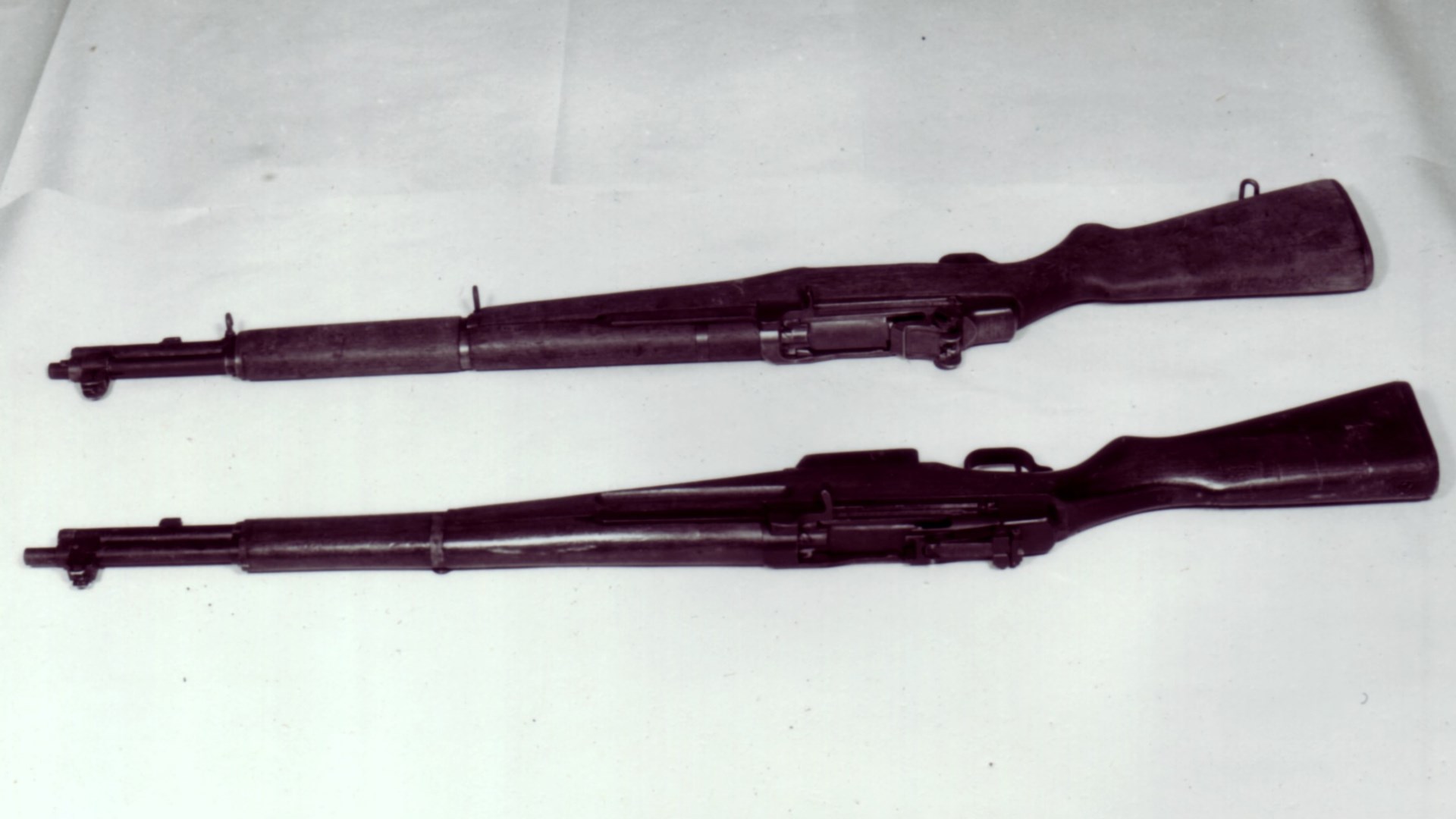
World War II finally ended after the atomic bomb attacks on Hiroshima (August 6) and Nagasaki (August 9). While the casualties from the two nuclear blasts were horrific, they pale in comparison to projected number of deaths if dozens of Allied infantry divisions assaulted Japan and Japanese militarist plans to sacrifice the entirety of their population to stop them came to fruition. Armed with bamboo spears and an odd assortment of crude firearms, the Japanese Volunteer Fighting Corps would have inflicted their share of casualties on the invaders, but the utter and tragic destruction of Japan and its people would certainly have followed.
Betcha Old NFO Heard this one, LOL
I actually heard this song in 1987, I had picked up a "60's mix cassette(yes a cassette) at a rest stop off the autobahn near Trier in Germany near the Luxemburg border. Trier was originally a Roman city back in the day...I was on a road trip and my regular group of songs that I carried in my Mustang were sounding real tired. I really enjoyed this cassette and the mix of 60's songs...some of them I remembered my Dad playing and others that I have never heard of. It made the trip a little less long....Trier was a long way from Stuttgart where I was stationed. I think I wore the cassette out when I was in the Gulf, that sand got into everything , but I still have my boombox radio that I had bought from the PX, the radio looks worse for wear, and one of the cassette players quit working....I am sure the door getting torn off was a factor in that. Here is the radio in my bonus room with all of my other souvenirs of my travels.
"In the Year 2525 (Exordium et Terminus)" is a 1969 hit song by the American pop-rock duo of Zager and Evans. It reached number one on the Billboard Hot 100 for six weeks commencing July 12, 1969. It peaked at number one in the UK Singles Chart for three weeks in August and September that year. The song was written and composed by Rick Evans in 1964 and originally released on a small regional record label (Truth Records) in 1968. A year later, an Odessa, Texas, radio station popularized the disc, which RCA Records quickly picked up for nationwide distribution. Zager and Evans disbanded in 1971. Denny Zager now builds custom guitars in Lincoln, Nebraska.
"In the Year 2525 (Exordium and Terminus)" opens with the words "In the year 2525, If man is still alive, If woman can survive, They may find...". Subsequent verses pick up the story at 1010-year intervals from 2525 to 6565. Disturbing predictions are given for each selected year. In the year 3535, for example, all of a person's actions, words and thoughts will be preprogrammed into a daily pill. Then the pattern as well as the music changes, going up a half step in the key of the song, after two stanzas, first from A-flat minor, to A minor, and, then, finally, to B flat minor, and verses for the years 7510, 8510 and 9595 follow.
The song has no chorus. Amid ominous-sounding orchestral music, the final dated chronological verse is,
The summary verse concludes:
The song goes back to the beginning, starting all over again, with 2525 before the song's fade.
The overriding theme, of a world doomed by its passive acquiescence to and overdependence on its own overdone technologies, struck a resonant chord in millions of people around the world in the late 1960s.
The song describes a nightmarish vision of the future as man's technological inventions gradually dehumanize him. It includes a colloquial reference to the Second Coming (In the year 7510, if God's a-coming, He ought to make it by then.), which echoed the zeitgeist of the Jesus movement.
A guy named Michael Smith Posted this Rebuttal on farcebook. I shamelessly clipped it.
I didn't post yesterday, had a lot of work stuff going on Yesterday and got squirreled.
We in the Airlines fall under the "National Railways Act", the airlines got added in 1936. The airlines are considered part of the transportation link of the United States so the ability to strike is limited. Before a strike, both parties have to go before a arbitration board to iron out the differences. Most people fall under the "Fair Labor Standards Act", this is the one that gives you the 40 hours a week, the time and half after 40 and so forth, and the minimum wage comes from this one. The Big Beautiful Bill No Tax on Overtime only affects the people under the "FLSA", so we airline people are exempt from that bennie. Also a bit of info on that, the no tax only goes for anything after 40 hours until the cap of $25,000 if you are married(Yearly) after that, the tax goes back in. and if you are single, it is $12,500. I did a bit of research into it 'splaining it to my "workwiths", lol
I know a few people from NWA that lost their jobs and now work for my employer, they are really good mechanics and are exceedingly bitter. This is part of the reason that my employer is non-union with the exception of the Skykings, er Pilots. They feel like they were betrayed by their union and sold down the river. The union in their mind pushed for the strike, and when the company brought in "Scabs", the company basically fired the striking workers and the union organized the scabs. so there is a lot of anger there. The stories they talk about has warned a lot of impressionable younger mechanics that might be persuaded by the siren song of the unions that have tried twice to organize my employer and failed. IAM and AMFA have tried, and so far have been unsuccessful.
Just a bit of background. And for those that don't know, I was a shop steward or union Rep for the UAW at Ford Motor Company, so I know a bit how unions work, They have good and bad points. I have "Talked" about that in the past.
I got the article from "Aviation Week"

This year marks the 20th anniversary of an event that permanently affected aviation maintenance for airlines and yet was barely noticed by the flying public—the Northwest Airlines/Aircraft Mechanics Fraternal Association mechanics’ strike.
Like many legacy airlines in the early 2000s, the glory days of profitability from the previous decade(s) were a distant memory. The harsh economic environment forced the major airlines to cut costs to survive, while many smaller airlines folded.
At Northwest Airlines (NWA), all salaried and union employees had accepted concessionary compensation, with the exception of the Aircraft Mechanics Fraternal Association (AMFA). Prevailing speculation was that AMFA leadership eyed the larger membership representation votes at other majors and would not accept concessions, despite understanding NWA’s financial fragility. With negotiations continuing to deteriorate in 2004, the NWA leadership began planning to operate the airline in the event of an AMFA workforce strike.
AMFA represented more than 5,000 NWA employees, and replacing them in a single night was extremely challenging. Above all, an effective contingency plan had to have some critical deliverables:
• The airline’s operations would run at 100% and had to remain safe and compliant.
• The airline had to maintain the confidence of the aircraft crews, the FAA and the flying public.
• The whole team had to be committed to achieving the plan, and the CEO and the board had to believe the plan could be executed (since failure would have shut down the airline).
While the final plan was enormously detailed, the most critical task was sourcing and certifying replacement personnel and providers for:
• 1,500 line maintenance mechanics in 31 maintenance stations.
• All aircraft heavy maintenance.
• All engines and auxiliary power units.
• Aircraft cleaners in 12 station locations.
• Mechanics conducting aircraft pushbacks at 28 station locations.
• Ground radio technicians in one location.
• Plant and facilities technicians in 13 locations.
• Home for every part—source and certify component maintenance providers to support the repair of about 10,000 individual components.
• Almost 3,000 flight attendants in the event they conducted sympathy labor actions.
Preparing to replace this amount of work was difficult in itself, but the real challenge was time.
The airline estimated that the negotiations process would likely end in the late summer/early fall if AMFA were to strike. When a fully dedicated project team started detailed preparation, it was seven months before the airline had to be ready.
The airline’s managers collectively dedicated tens of thousands of extra hours to the preparation. Days flowed into nights, and many weekends were spent working on endless details. Training centers were set up in remote cities in just weeks. Approval processes were reduced from months to days and hours. Support groups like security, information technology and human resources were enormously responsive.
When AMFA called the strike on Aug. 20, 2005, the previous weeks’ operations had been burdened by a significant spike of deferred maintenance (minimum equipment lists items and nonessential equipment and furnishings), delays and out-of-service aircraft resulting from disruptive behavior. Despite this, the tech ops team was ready. The AMFA mechanics were escorted off the property, and execution of hundreds of detailed checklists began in every station and work area.
Everything was inspected for serviceability, including aircraft, vehicles, ground support equipment and computer and phone lines. Replacement personnel were bused in, issued toolboxes and began work. Maintenance and cleaning providers entered facilities all over the country and began working. Enhanced quality oversight began immediately.
By 7 a.m. the next day, the checklists were complete, and the airline was up and running. As the days went on, the operational burdens were significantly reduced, and the operation began to run at historically normal reliability but at much lower cost.
After 444 days, AMFA settled with the company, but, sadly, many good AMFA-represented employees had permanently lost their jobs due to the union’s decision to strike.
For the maintenance team that had shown that a workforce could be completely replaced at an airline, those tough days had bonded them together. They had been through the most intense period in their careers. They had built relationships with many new team members in different roles, and they had sacrificed a lot of time with their families. Today, many still proudly say they feel like they fought a war together.
I have seen on Insty and other social media about the drama about certain women and I have joked with my wife should she cross over the rim before me, I ain't remarrying again, the current dating pool is toxic. The 4th wave of feminism and the "Girlboss" has poisoned the dating pool as far as I am concerned. I could myself fortunate that I am still on my "Starter Marriage" and we have been together for almost 32 years. I am sure that there are a lot of good girls out there but do I want to try to find them? Is the juice worth the squeeze? I hope I never find out.
I saw this on "Art of Manliness"
You’ve probably had a friend who started dating a woman that really made you scratch your head. She was flaky, possessive, and high-drama. Everyone could see that the gal was toxic and really bringing your buddy down…everyone, that is, except your buddy.
You tell yourself, “That would never happen to me.”
But then it does.
What gives? How do people end up in unhealthy relationships despite warning signs that their partner was bad news to begin with?
Answer: we’re blinded by love.
Seriously.
Using MRI machines, researchers at the University College London found that “feelings of love lead to a suppression of activity in the areas of the brain controlling critical thought. It seems that once we get close to a person, the brain decides the need to assess their character and personality is reduced.”
Not only does romantic love suppress our critical thinking, but feel-good chemicals and hormones like oxytocin and dopamine cloud our judgment even more. Love truly gives us a drug-like “high,” and it feels so good that we simply ignore the red flags waving right before us. If by chance you do take notice of a gal’s negative behavior or attitude, you’re likely to minimize it, writing it off as a cute quirk, or telling yourself, “Oh, it’s not that bad. Besides, maybe I can be the guy to help her improve.”
Don’t fool yourself. You can’t force your partner to change; the change has to come from within. Also, problems that you notice at the beginning of a relationship tend to amplify themselves as the relationship deepens. Or as marriage expert Dr. John Van Epp says in his book, How to Avoid Falling in Love With a Jerk, “The good doesn’t always last, and the bad usually gets worse.”
“Well,” you say, “I’m a manly man, dammit. I don’t let my emotions get the best of me in a relationship. I always think rationally.”
Hold on there, chief. Some research actually indicates that men, particularly men in their mid-twenties, “typically fall in love faster than women and are the first to take the lead in saying words of love in the initial stages of the relationship.” Women, on the other hand, are generally more apprehensive in the beginning stages of a relationship. In other words, just because you’re a dude, doesn’t mean you’re not susceptible to love blindness.
Knowing that your judgment is clouded, it’s important to enter any serious relationship with both your head and your heart. You need be able to distance yourself from the powerful emotions you’re likely feeling in a new relationship so that you can notice any red flags that might indicate that you’re destined for a relationship from hell. This is doubly important if you’re considering marriage.
But what sort of red flags should you be on the lookout for? While every man has his own personal relationship red flags or deal breakers, psychologists and marriage experts have found there are a few general red flags you should be aware of. Most of these are patterns of behavior in your partner that will likely (not definitely) result in a troubled relationship down the road.
Because people are usually on their best behavior at the beginning of a relationship, some of these red flags won’t appear for awhile. According to Dr. Van Epp, it’s usually around the three-month mark that deep-seated patterns start to manifest themselves. This delay is why he and other relationship experts recommend that you take romantic relationships nice and slow.
Below are some of the common red flags that researchers and therapists recommend you look for in a relationship.
1. She’s a self-proclaimed “Drama Queen.” Beware of women who not only proclaim themselves to be Drama Queens, but also revel in the role. Drama Queens often swing from one emotional extreme to another; when life seems a little boring or flat, they’ll go out of their way to stir up a controversy. They’re often impulsive and demand to be the center of attention all the time. What’s interesting is that Drama Queendom isn’t just a character defect, it could actually be a psychological disorder called “histrionic personality disorder.” Who knew?
Drama Queens can be very alluring and attractive in the beginning of the relationship because of their seemingly outgoing and often seductive personalities. But the shtick gets old after a while and constant drama in a long-term relationship just makes people miserable.
2. You can’t stand any of her friends. You don’t need to be “besties” with her friends, but if the thought of spending an hour with one of them makes you want to jump in front of speeding traffic, then you might have reason to be concerned about your relationship with your gal. There’s wisdom in the old adage, “Birds of a feather flock together.” Your significant other likely has a lot in common with her friends — similar interests, temperaments, and beliefs. Because you’re not in love with her friends, you’re more likely to notice their annoyingly grating behaviors and attitudes. But because you’re infatuated with your gal, you’re likely ignoring or overlooking these same behaviors and attitudes coming from her.
Thus, if you can’t stand being around her friends now, there’s a chance you’ll feel the same way about your partner later. Don’t be surprised if your girlfriend is just like her annoying friend after the “Fog of Love” dissipates.
3. She says ALL her exes are jerks. There’s a possibility that every man she’s ever dated was indeed a jerk. If that’s the case, what does that say about her judgment, and what is it about her personality that draws her to losers? And that also means you’re probably a jerk too, as people tend to follow the same scripts and patterns across relationships.
The more likely scenario is that some — but not all — of her exes were jerks and she’s downplaying her role in the relationships going sour. This scenario is just as troublesome – as it shows a lack of self-awareness and an unwillingness to take responsibility. We all know folks who got fired from a job, received a bad grade, or got dumped because their boss was jealous, their professor was out to get them, and their girlfriend was nuts. It’s never their fault. Avoid relationships with this type of person like the plague.
4. She’s a flake. We all know that trust is an important aspect of a strong, healthy relationship, and it’s hard to trust someone who flakes out on you all the time. Watch to see if your gal follows through on her commitments in all aspects of her life. If she’s a flake with her employer, friends, and family, chances are she’s going to be a flake with you.
5. She treats waiters like crap. You can glean important information about a person from the way they treat strangers, especially those in a “server” role like a waiter, barista, or bank clerk. Psychologists have found that the way an individual treats strangers is often an indication of that person’s empathy, social conscience, and maturity of moral thinking — the same attributes that marriage and relationship researchers have found to be essential for healthy relationships.
6. She expects to be treated like a princess. When one person comes into a relationship with a sense of entitlement and expectation that his or her needs should always come before the other person’s, resentment, contempt, and anger are usually the results. Be on the lookout for subtle and overt clues that your partner has the “princess” mentality. (Hint: She has the word “Princess” stitched on the butt of her sweatpants.)
7. You argue all. the. time. There’s nothing wrong with conflict in a relationship. It’s completely normal, and in fact healthy at times. But if all you do is argue, then there’s a problem. Researchers have found that for a relationship to be happy, the ratio of positive to negative interactions needs to be 5:1. If your ratio is inverted, you’re going to be miserable. And don’t try to convince yourself that once you get more serious, things will get better. The first couple years are the honeymoon period! If things are already bad in the early stages of a relationship, you’re in big trouble.
8. She gets angry or guilts you when you want to spend time with your friends. We’ve talked a lot on the site about how important it is for men to spend time with their man friends — iron sharpens iron and all that. Unfortunately, some women don’t understand this and bust their boyfriend’s balls any time they want to go spend time with their buds – or they insist on always coming along to your formerly all-guy outings. A good woman will actually encourage you to spend time with the guys, understanding that it’s good for your overall well-being, which is ultimately good for your relationship too.
9. She never apologizes or takes responsibility for bad behavior. Psychologists call the ability to recognize and take responsibility for bad behavior conscientiousness, and it’s an important attribute in maintaining a healthy relationship.
“What you want to see is a partner who quickly admits to wrong because the feelings of guilt register without much defensiveness or denial. Long arguments where you have to convince your partner that he or she was wrong or should feel guilty are a definite reason to worry,” says Van Epp.
10. She has a bad relationship with her family. As the relationship gets more serious, you’ll likely meet her parents and family. Watch how she interacts with them. Her comfort level with her family will often lead to her putting down her guard and showing her true colors. Patterns or scripts that your partner uses in one set of relationships will most likely be introduced into your relationship (Van Epp). If she gets along great with her family, great! You’ll likely experience the same in your relationship. However, if she’s cold and distant with her family, tread carefully. You might experience the same kind of hostility later.
Of course, there are cases where the apple truly does fall far from the tree. If her family is nuts or abusive, her distance is understandable and likely a good thing.
11. She’s not flexible. Marriage and relationship experts have found that flexibility — the ability to go with the flow and adapt to changing circumstances — is an important attribute for relationship success. If your girlfriend is never willing to compromise or gets frazzled when plans change or things aren’t exactly the way she wants them, there could be problems with your relationship down the line.
How do you know if your gal is the roll-with-the-punches type? Go on vacation together – ideally to a third-world country where things will invariably not go as planned. Or, just as good, take her camping. She refuses to go camping – even once? That’s a big red flag in itself – at least in my book.
12. You don’t share any core values or life goals. It doesn’t matter how much you love each other, if you and your gal aren’t on the same page when it comes to things like values or life goals, things are going to be rocky. Research backs this up — couples who share many of the same values and life goals are happier and have stronger relationships than couples who don’t.
13. She’s violent. Did you know that women are at least as likely, sometimes even more likely, than men to initiate domestic violence? Sure, her punches may not hurt you, but if your girlfriend gets violent when you argue, that should be a bright red flag that you need to end the relationship. There’s some underlying emotional issues there, and if she did it before, she’ll likely do it again. Don’t shrug it off – slapping can escalate into the use of weapons.
14. She’s stingy with the appreciation. Feelings of appreciation keep a relationship strong and running smoothly. One of the things I love about Kate is no matter how many times I’ve done a run-of-the-mill chore or how small a favor, she always remembers to take notice and share her appreciation. If your girlfriend rarely notices and thanks you for the nice things you do, such stinginess will eventually run your ship of love onto the rocks.